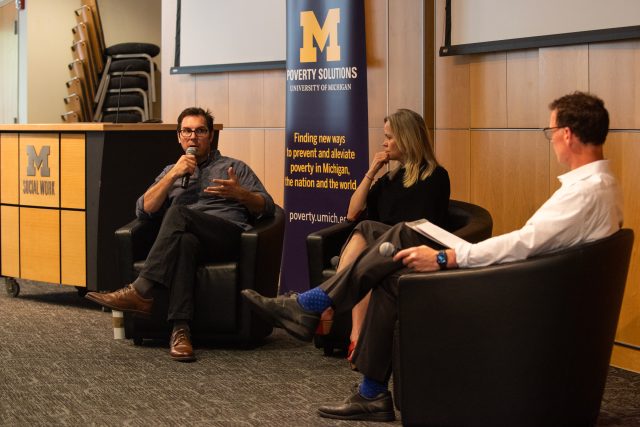[ad_1]
More than 100 University of Michigan students, faculty and staff attended the first event of the sixth annual Real-World Perspectives on Poverty Solutions Speaker Series Friday afternoon. As part of the event, Amy Toensing and Matt Moyer, spouses who are both documentary filmmakers, gave a talk and screening of their film “Inheritance,” which was followed by a Q&A session. The event was held by U-M Poverty Solutions.
The documentary follows the life of a boy named Curtis and his family for over a decade as he navigates a household stuck in a cycle of addiction and poverty in rural Ohio. During the event, Toensing and Moyer spoke about the relationships between poverty and substance abuse, mental health, trauma and rurality. Moderator Joseph Ryan, professor of Social Work, and Toensing and Moyer kicked off the talk by discussing the context behind the film. Toensing and Moyer said they began the project over a decade ago when Moyer met a man named JP while looking into food security in Appalachia. Moyer found JP’s life story incredibly moving, and wanted to do a documentary on his life.
While starting this project, Moyer and Toensing met JP’s family, including his son Curtis. Toensing explained how Curtis came to be the focal point of the documentary.
“We thought with Curtis narrating the story, or being the main character in the story, it would give the audience an opportunity to have more empathy for the challenges that Curtis and his family are up against,” Toensing said. “Our hope was to allow the viewer to look at Curtis and say, ‘I could have been Curtis. Any of us could have been Curtis.’”
In their decade with Curtis’ family, Toensing and Moyer witnessed the kids be placed in foster care a number of times. The documentary, however, emphasizes positive relationships within the family. Toensing said she and Moyer made this directorial decision because they wanted to challenge people to think about the role of foster care.
“It was very damaging for them to be taken away,” Toensing said. “(But) also there’s issues at home. So I would think that is one of the biggest challenges for all of you as you head out into the world of social work; how do you navigate that? Because there is love in these families. These kids need their parents. But how do you navigate some of the really hard mental health issues that are going on at home?”
While substance abuse and mental health issues occur everywhere, Moyer said it can be particularly difficult to break the cycle in rural areas, like the one Curtis’ family lives in. Moyer said this problem is caused by a simple lack of opportunity or ability to get help.
“The struggles we saw while we were filming exist everywhere … intergenerational trauma, poverty, which is its own trauma, substance use disorder — those same things are cyclical in urban and rural environments,” Moyer said. “(But) in the rural context, there’s just a lack of services, (and) we have been stunned by the logistical difficulties that exist for folks.”
During the Q&A portion of the talk, Toensing was asked about the main themes of the film and drivers of poverty. Toensing explained that though the film focused largely on addiction and generational trauma, it did not have one overarching theme, just as poverty does not have one overarching reason.
“This isn’t really about addiction, because this isn’t just about this one drug,” Toensing said. “This is five generations who have battled addiction to alcohol, cocaine — you name the drug, it’s been part of this family. So clearly, (poverty) is not about that one drug. It’s not about a border wall, it’s not about any of those things. It’s actually about community. It’s about the foster care system and family structure. It’s about jobs. It’s very complex.”
Moyer said he and Toensing could not focus solely on poverty in the film because all the causal cycles were interconnected.
“It’s completely intertwined, that is something that I think we can see in communities,” Moyer said. “All of us know of communities that have fallen on hard times, that have struggled for jobs and industry has left. There’s always an uptick of difficulties related to homelessness, self worth and mental health (and) more.”
In an interview with The Michigan Daily about interconnected factors of poverty, Social Work student Nicole Portmann Munoz said this was one of the reasons why she had been interested in the event.
“As social workers, we’re called to understand the holistic view of patients, instead of just what they’re presenting,” Munoz said. “The social determinants of health (really) shape the lives of our clients. So I think (the film) helps shape and further a more macro perspective of health.”
Daily Staff Reporter Lyra Wilder can be reached at lyrawild@umich.edu.
Related articles
[ad_2]
Source link











